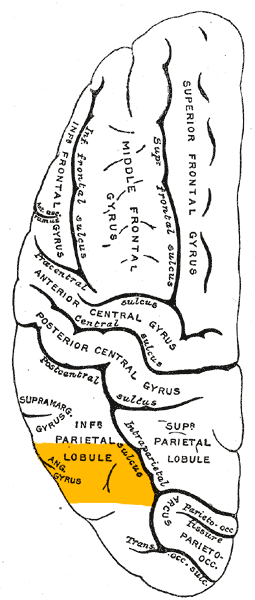Angular gyrus
| Angular gyrus | |
|---|---|
| 250px Location of the angular gyrus (shown in red) | |
| Details | |
| Artery | Middle cerebral artery |
| Identifiers | |
| Latin | gyrus angularis |
| TA98 | Lua error in Module:Wikidata at line 746: attempt to index field 'wikibase' (a nil value). |
| TH | {{#property:P1694}} |
| TE | {{#property:P1693}} |
| FMA | {{#property:P1402}} |
| Anatomical terms of neuroanatomy [[[d:Lua error in Module:Wikidata at line 865: attempt to index field 'wikibase' (a nil value).|edit on Wikidata]]] | |
The angular gyrus is a region of the brain located in the parietal lobe. It lies near the superior edge of the temporal lobe, immediately posterior to the supramarginal gyrus. The angular gyrus is involved in a number of processes related to language, number processing, spatial cognition, memory retrieval, attention, and theory of mind.
Anatomy[edit | edit source]
The angular gyrus is part of the parietal lobe and is situated at the posterior end of the sylvian fissure. It is bounded anteriorly by the supramarginal gyrus, inferiorly by the superior temporal gyrus, and posteriorly by the occipital lobe. The angular gyrus is supplied by the middle cerebral artery.
Functions[edit | edit source]
The angular gyrus plays a crucial role in various cognitive functions. It is involved in:
- Language processing: The angular gyrus is essential for the comprehension of written language. It is involved in the process of reading and converting written words into an internal monologue.
- Number processing: This region is also implicated in arithmetic and number comprehension.
- Spatial cognition: The angular gyrus helps in understanding spatial relationships and in the perception of spatial orientation.
- Memory retrieval: It is involved in the retrieval of episodic memories.
- Attention: The angular gyrus contributes to the allocation of attention to different stimuli.
- Theory of mind: This region is associated with the ability to understand the mental states of others.
Clinical significance[edit | edit source]
Damage to the angular gyrus can result in various neurological conditions, including:
- Gerstmann syndrome: A neurological disorder characterized by agraphia, acalculia, finger agnosia, and left-right disorientation.
- Alexia: The inability to read, often due to damage in the angular gyrus.
- Agraphia: The inability to write, which can also be associated with damage to this region.
Related pages[edit | edit source]
Navigation: Wellness - Encyclopedia - Health topics - Disease Index - Drugs - World Directory - Gray's Anatomy - Keto diet - Recipes
Search WikiMD
Ad.Tired of being Overweight? Try W8MD's physician weight loss program.
Semaglutide (Ozempic / Wegovy and Tirzepatide (Mounjaro / Zepbound) available.
Advertise on WikiMD
WikiMD is not a substitute for professional medical advice. See full disclaimer.
Credits:Most images are courtesy of Wikimedia commons, and templates Wikipedia, licensed under CC BY SA or similar.Contributors: Prab R. Tumpati, MD






